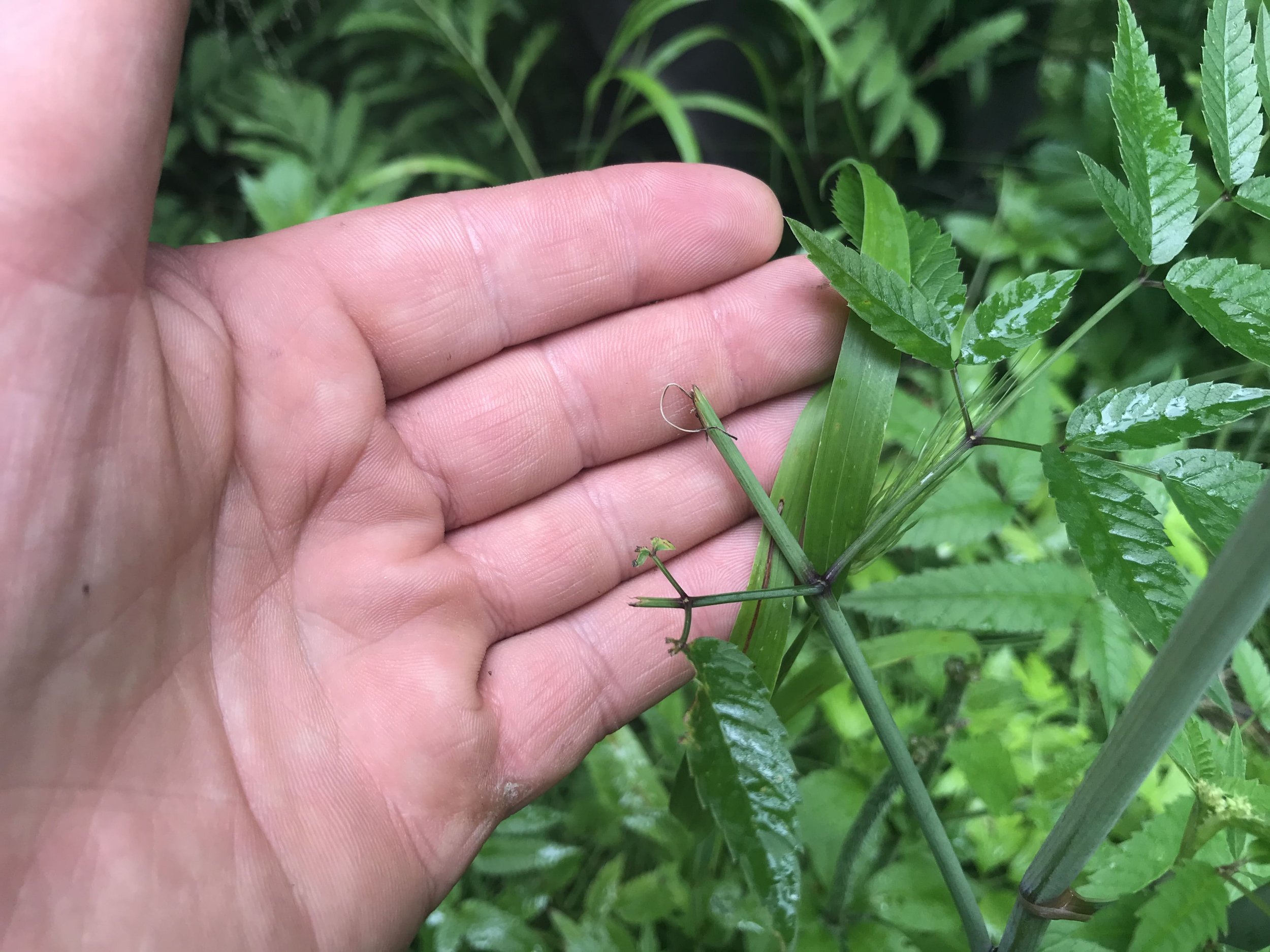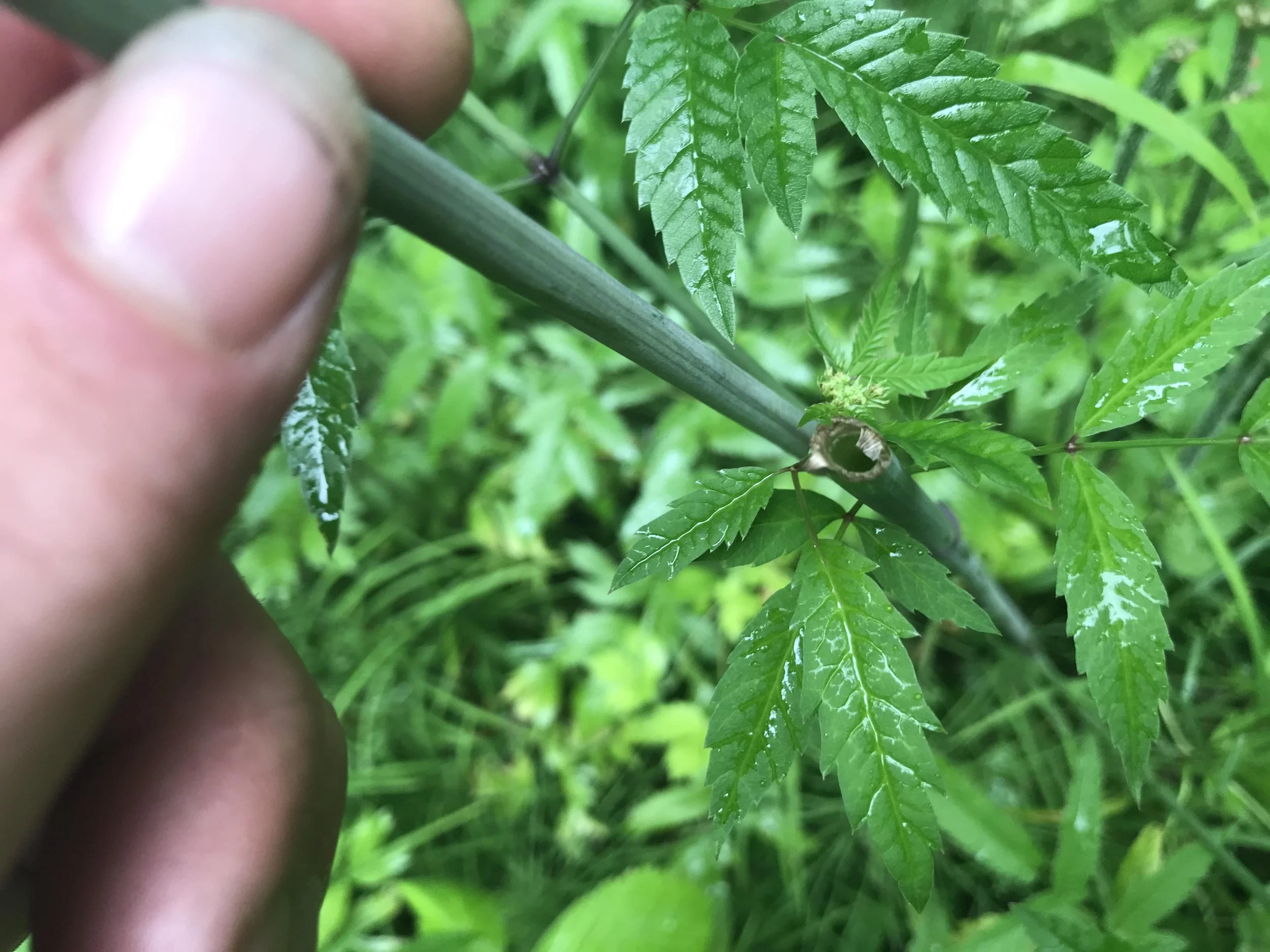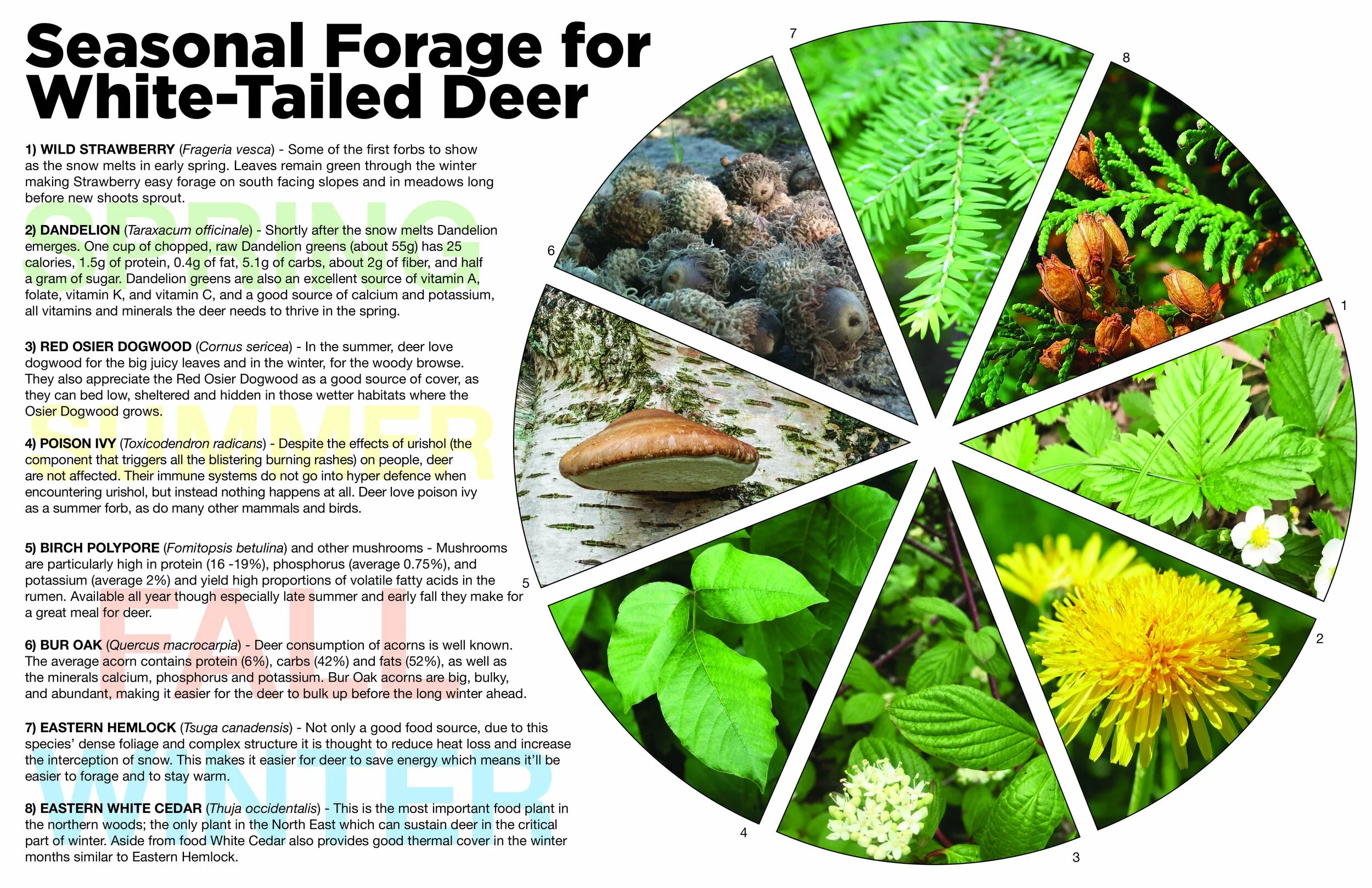White-tailed Deer consuming Water Hemlock
White-tailed Deer (Odocoileus virginianus) consume a lot of different things. It seems everytime I see some Deer browse, it appears to be a new forb, shrub, or tree which I hadn’t seen a Deer browse before. I wanted to look into the foods which Deer browse more generally, but also focus on a new discovery of Deer browse on the aerial parts of Water Hemlock (Cicuta maculata).
First, lets consider how Deer eats. White-tailed Deer lack upper front teeth (incisors), and instead have a relatively flat palate. When the Deer want to eat, they grasp the plant with their lower incisors against the upper palate, pinching it in place, and then tear off the end of the plant which is in their mouth. This often leaves a bit of a frayed messy end remaining on the branch.
White-tailed Deer browse, perhaps on White Elm (Ulmus americana) off of Cooks Mill rd, Guelph Ontario. 2022.02.08.
White-tailed Deer consume a wide variety of things crossing at least kingdoms of life; flora, funga, and fauna. Some interesting members of each kingdom which I have seen Deer consume are :
Flora :
POISON IVY (Toxicodendron radicans) - Despite the effects of urishol (the component that triggers all the blistering burning rashes) on people, deer are not affected. Their immune systems do not go into hyper defence when encountering urishol, but instead nothing happens at all. Deer love poison ivy as a summer forb, as do many other mammals and birds.
Funga :
BIRCH POLYPORE (Fomitopsis betulina) - Mushrooms are particularly high in protein (16 -19%), phosphorus (average 0.75%), and potassium (average 2%) and yield high proportions of volatile fatty acids in the rumen. Available all year though especially late summer and early fall they make for a great meal for Deer. The Birch Polypore has high concentrations of betulinic acid derived from the Birch (Betula spp.) trees they inhabit. Betulinic acid has been found to be a powerful antimicrobial (1), anticancer and antitumor (2) compound for humans. I have long wondered if the Deer consume this fungi for these medicinal compounds?
Fauna :
While I have not seen this myself, there have been many recorded instances of White-tailed Deer consuming meat. It seems that the classifications of herbivore, omnivore and carnivore aren’t as rigid as we sometimes let ourselves believe. We probably all know a vegan who might try a piece of venison once in a while, or the carnivore who loves to steal an onion ring off of your plate every now and then.
I think it would also be useful to consider a couple of terms sometimes folks use interchangeably, but I have also heard meaning two different things; browse and forage. When a Deer is browsing they are grabbing food from woodier plants, usually up a little higher than the ground. This can be mast as well (nuts, fruit, seeds, etc). Grazing implies the Deer getting food from the ground level, such as grasses, sedges, and low growing forbs. While this may seem a little uptight in the definitions, I think it helps to be precise sometimes.
Speaking of the benefits of focus, I wanted to get into what I started writing this entry about in the first place. Some backstory : While out tracking with the Earth Tracks Wildlife Tracking Apprenticeship this past weekend we came across a ton of Water Hemlock (Cicuta maculata) in a beautiful wetland on the South branch of the Saugeen River. A great discovery while checking out the Hemlock in the area was finding White-tailed Deer browse on a couple of the plants. It appeared as if the Deer were munching away on the Valerian (Valeriana officinalis) and Black Raspberry (Rubus occidentalis) in the uplands, and Spotted Joe-Pye Weed (Eutrochium maculatum) in the lower wetter areas. They also seemed to get a couple nibbles in on the Water Hemlock as well. I had heard of the Deer browsing the Hemlock before, as mentioned in my recent article on Water Hemlock, but had never documented this myself. I also recognize that the aerial parts are not as toxic as the roots, but I wonder if there are any known fatal incidents of Deer browsing the Hemlock? There is none that I have read or heard about yet. Does their four chambered stomach enable them to consume such a powerful plant unscathed? The first of the four chambers, the rumen, can hold approximately 8 L of material which allows the Deer to feed quickly, and then move off to a protected area to chew their cud and digest in relative safety from potential predators. Does this quick eating mean less discernment, and eating the Hemlock is more of a mistake? Or are they using the plant medicinally somehow? If so, what action does the Hemlock have on their bodies? I did find a paper which noted White-tailed Deer depredation of Victorin’s Water Hemlock (Cicuta maculata var. victorinii), an endemic variety of Water Hemlock native to a couple of small islands in the St. Lawrence River. It seems like the Deer were browsing on these rare plants, but not enough to destabilize the populations on the islands studied, and there was no mention of how the plant might affect the Deer.



I have been researching this for a couple of days now, and so far there is nothing in the literature that I can find that is leading me anywhere useful. I have some assumptions, but they are only assumptions, nothing backed up by experiment or observation, just applied knowledge and conjecture.
The aerial parts of the plant are not as toxic as the roots, and if the Deer are browsing the aerial parts and not the roots, then this shouldn’t be as harmful as we might imagine it could be. I believe the four stomachs enable an ability to break down complex chemicals which could act as potential toxins before really getting into the blood stream, and really harming the Deer. Also, they only consume one or two branches of the Hemlock amidst the abundant other plants they feed on, diluting an already small quantity of plant matter with a likely small quantity of toxins. Perhaps, not that much happens for the Deer at all when they feed on Water Hemlock. Maybe it’s like me eating some kinds of dairy - I get a little bloaty and gassy, but then it’s over and I’m back to normal. I would love to try and work on my trailing skills enough to be able to follow a Deer from a browsed Hemlock to a bed and to investigate the scat and see if it has any strange and abnormal characteristics? Who knows, maybe it would be extra runny or be coated in a thick mucus. I have no idea.
Seasonal Forage for White-Tailed Deer poster - pdf download of this image. Poster created for the Earth Tracks Wildlife Tracking Apprenticeship in 2019.
Often when I write these entries my hope is to share something I have learned about my questions, but sometimes we don’t find the answers we are looking for right away. Perhaps in a few years someone will write a paper on the subject, and I’ll come across it and all the questions will be settled and answered. Until then, the wonder continues.
To learn more :
The Deer of North America by Leonard Lee Rue III. The Lyons Press, 1997.
Suivi de 3 plantes rares de l’estuaire d’eau douce du Saint-Laurent by Hélène Gilbert - pdf download
Seasonal Forage for White-Tailed Deer poster - pdf download


